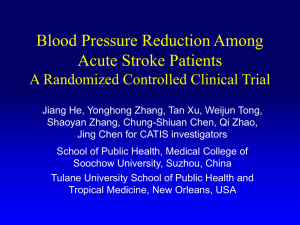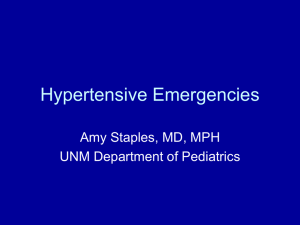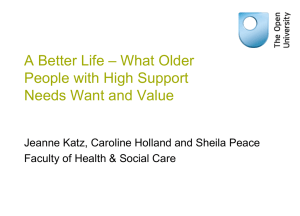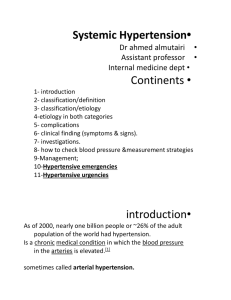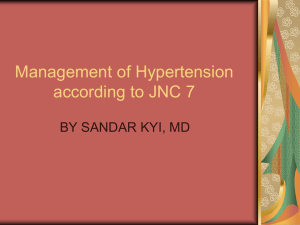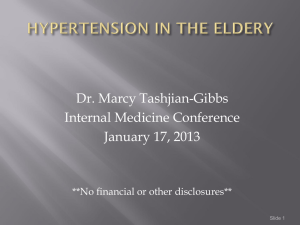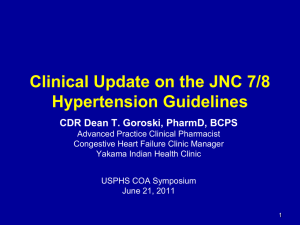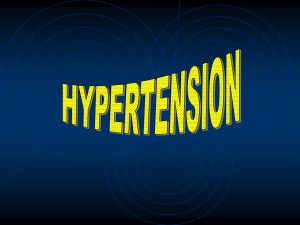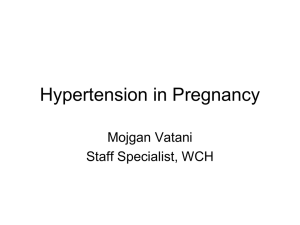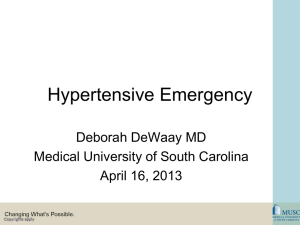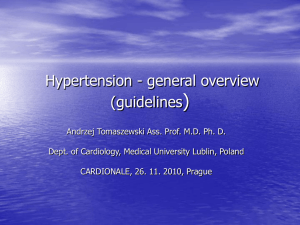Hypertensive Emergencies: Optimal Therapy in the ED
advertisement
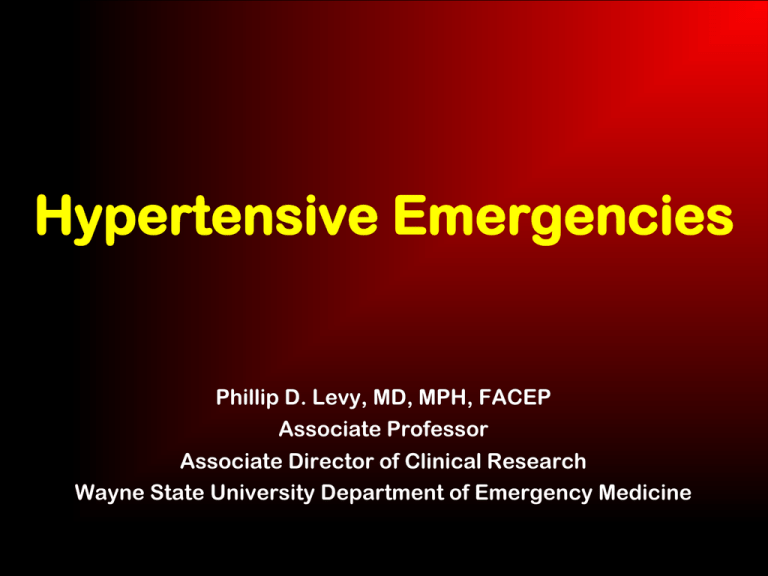
Hypertensive Emergencies Phillip D. Levy, MD, MPH, FACEP Associate Professor Associate Director of Clinical Research Wayne State University Department of Emergency Medicine Relevant Disclosures • Grant/Research Support – The Robert Wood Johnson Foundation Physician Faculty Scholars Program, the NIH Loan Repayment Program (Health Disparities Division), and the NIH/NIHMD (1R01 MD005849-01A1) • Consultant – The Medicines Company, EKR Therapeutics Purpose of This Lecture • To provide an overview of the “what” and “why” of contemporary ED management of acute HTN – Utilize an evidence-based discussion format – Focus on differentiation between simple BP elevation and true hypertensive emergency Why This Topic? Nawar et al. Adv Data 2007; 386:1-32. Why This Topic? Pitts et al. Natl Health Stat Report 2008;7:1-38. Based on JNC VII Class http://www.nhlbi.nih.gov/guidelines/hypertension/jnc7full.htm Reflects the General Population Prevalence Lloyd-Jones et al. Circulation 2010;121;e1-e170. As Well As Racial and Ethnic Demographics Lloyd-Jones et al. Circulation 2010;121;e1-e170. And Low Levels of Awareness, Treatment and Control Lloyd-Jones et al. Circulation 2010;121;e1-e170. So The BP is High - Now What ? http://www.nhlbi.nih.gov/guidelines/hypertension/jnc7full.htm So The BP is High - Now What ? http://www.nhlbi.nih.gov/guidelines/hypertension/jnc7full.htm So The BP is High - Now What ? http://www.nhlbi.nih.gov/guidelines/hypertension/jnc7full.htm Shayne and Pitts. Ann Emerg Med. 2003;41:513-29. Are All of These Patients the Same? Kessler and Joudeh. Am Fam Physician. 2010;81:470-76. Clearly Not! Kessler and Joudeh. Am Fam Physician. 2010;81:470-76. What Constitutes a Hypertensive Emergency? 1,2 1 2 Varon and Marik. Chest 2000;118:214-27. Rynn et al. J Pharm Prac 2005;18:363-76. Pathophysiology of a Hypertensive Emergency1,2 1 Ault 2 and Ellrodt. Am J Emerg Med 1985; (suppl 6):10-15. Varon and Marik. Chest. 2000;118:214-27. Chirinos and Segers. Hypertension 2010;56:563-70. Macrocirculatory: Arterial Impedance Kawaguchi et al. Circulation 2003;107:714-20. What End-Organs Are Typically Involved? Zampaglione et al. Hypertension 1996;27:144–7. Katz et al. Am Heart J 2009;158:599-606. Patient Outcomes Katz et al. Am Heart J 2009;158:599-606. Szczech et al. Circulation 2010;121:2183-91. Deshmukh et al. Am Heart J. 2011 [epub ahead of print]. Stead et al. Neurology 2005;65:1179-83. Gheorghiade et al. JAMA 2006;296:2217-26. Perez et al. Cochrane Database of Systematic Reviews 2008, Issue 1. Art. No.: CD003653. Perez et al. Cochrane Database of Systematic Reviews 2008, Issue 1. Art. No.: CD003653. Treatment Typically Parenteral • Adrenergic receptor blockers – – – – Esmolol (β1) Labetalol (α1 and β) Phentolamine (α1) Urapidil (α1) • Ca2+ channel blockers – Nicardipine – Clevidipine • ACE inhibitors – Enalaprilat • NO donors – Nitroprusside – Nitroglycerin – Isosorbide dinitrate • NP analogue – Nesiritide • Dopamine agonist – Fenoldopam • Direct vasodilator – Hydralazine What Is Used Most Commonly? Katz et al. Am Heart J 2009;158:599-606. How Well Does That Work? One First IV Antihypertensive Labetolol (n=501) 32% 40% Nitroglycerin (n=241) 41% Hydralazine (n=235) 41% Nicardapine (n=121) 25% 37% 27% 23% 32% 45% 51% 22% Three or more 42% Metoprolol (n=277) Sodium nitroprusside (n=82) Two 14% 28% 32% 21% 46% Percent of Patients Katz et al. Am Heart J 2009;158:599-606. Differential Antihypertensive Response Katz et al. Am Heart J 2009;158:599-606. Blood Pressure Dynamics • MAP = DBP + ([SBP - DBP]/3) • MAP = (CO x SVR) + CVP – CO = HR x SV Reference: Peacock et al. Peacock et al. Critical Care 2011 [epub ahead of print]. CLUE Study Evaluation of Intravenous niCardipine and Labetalol Use in the Emergency Department Reference: Peacock et al. Peacock et al. Critical Care 2011 [epub ahead of print]. CLUE Study Evaluation of Intravenous niCardipine and Labetalol Use in the Emergency Department Final multivariable logistic regression model†* for “met target SBP within first 30 minutes” Reference: Peacock et al. Peacock et al. Critical Care 2011 [epub ahead of print]. Specific Indications Rhoney and Peacock. Am J Health-Syst Pharm. 2009; 66:1343-52. How Low Should You Go? • Simple answer – 25% reduction in MAP within 1st hour – Target ~ 160/100 mm Hg by 2-6 hours Marik and Varon. Critical Care 2003, 7:374-84. How Low Should You Go? • Better answer – It really depends on clinical condition • Less aggressive with ischemic stroke • More aggressive with hemorrhagic stroke, acute HF and aortic dissection AHA/ASA Recommendations for BP Management in AIS Aiyagari and Gorelick. Stroke 2009;40:2251-56. AHA/ASA Recommendations for BP Management in AIS Aiyagari and Gorelick. Stroke 2009;40:2251-56. AHA/ASA Recommendations for BP Management in AIS Aiyagari and Gorelick. Stroke 2009;40:2251-56. AHA/ASA Recommendations for BP Management in ICH Aiyagari and Gorelick. Stroke 2009;40:2251-56. AHA/ASA Recommendations for BP Management in ICH Aiyagari and Gorelick. Stroke 2009;40:2251-56. Sandset et al. Lancet 2011 [epub ahead of print]. Sandset et al. Lancet 2011 [epub ahead of print]. Sandset et al. Lancet 2011 [epub ahead of print]. Impact of Early Reduction Rhoney et al. Presented at the 2011 Neuro-Critical Care Society Meeting. Impact of Early Reduction Rhoney et al. Presented at the 2011 Neuro-Critical Care Society Meeting. Guideline: SBP < 180 mm Hg Intensive: SBP < 140 mm Hg Anderson et al. Stroke 2010;41:307-12. But No Direct Clinical Benefit at 90 Days… Anderson et al. Lancet Neurol 2008;7:391–9. Antihypertensive Treatment of Acute Cerebral Hemorrhage (ATACH) investigators Crit Care Med 2010;38:637-48. Antihypertensive Treatment of Acute Cerebral Hemorrhage (ATACH) investigators Crit Care Med 2010;38:637-48. Hematoma Expansion Modified Rankin Scale Score Qureshi et al. Arch Neurol. 2010;67:570-6. Qureshi et al. Arch Neurol. 2010;67:570-6. BP Goal by 1 hr: 11% vs. 56% (p=0.02) Liu-DeRyke et al. Neurocrit Care 2008;9:167-76. n=51 n=20 n=51 n=20 Stead et al. Neurology 2006;66:1878–81. AHA/ACC Recommendations for BP Management in Acute HF Hunt et al. Circulation. 2009;119(14):e391-479. What About the Rest? Kessler and Joudeh. Am Fam Physician. 2010;81:470-76. Pitts and Adams. Ann Emerg Med 1998;31:214-8. Grassi et al. J Clin Hypertens 2008;10:662–7. BP Response to Rest Grassi et al. J Clin Hypertens 2008;10:662–7. Retrospective Cohort Study Untreated Treated n = 435 19 (4.4) 12 (2.8) 3 (0.7) 1 (0.2) p-value ED Visit 24 Hrs, n (%) ED Visit 24 Hrs Due to HTN, n (%) Hospital Admission within 24 Hrs, n (%) Complication at 24 Hrs Due to HTN, n (%) n = 581 14 (2.4) 7 (1.2) 0 (0.0) 0 (0.0) ED Visit within 30 d, n (%) ED Visit within 30 d Due to HTN, n (%) ED visit within 30 d for antihypertensive refill, n (%) Hospital Admission within 30 d, n (%) Complication within 30 d Due to HTN, n (%) 88 (15.2) 30 (5.2) 10 (1.7) 15 (2.6) 6 (1.0) 82 (18.9) 36 (8.3) 11 (2.5) 13 (3.0) 11 (2.5) 0.118 0.046 0.371 0.695 0.066 ED Visit within 90 d, n (%) ED Visit within 90 d Due to HTN, n (%) ED visit within 90 d for antihypertensive refill, n (%) Hospital Admission within 90 d, n (%) Complication within 90 d Due to HTN, n (%) 95 (16.4) 41 (7.1) 10 (1.7) 17 (2.9) 13 (2.2) 89 (20.5) 44 (10.1) 12 (2.8) 23 (5.3) 14 (3.2) 0.092 0.082 0.261 0.056 0.336 1 (0.2) 9 (1.6) 1 (0.2) 9 (2.1) 0.837 0.534 Death within 30 d, n (%) Death within 1 year, n (%) 0.082 0.070 0.450 0.248 Levy et al. Accepted for poster presentation at ACEP Scientific Assembly 2011 (San Francisco, CA). Wrap Up • Critical first step is to differentiate true emergencies from poorly controlled chronic hypertension • Intervention for emergencies should be driven by condition-specific goals – Involve more than just a number! – Equate with problems caused by acute HTN – Best achieved using co-morbidity congruous agents


